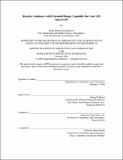Reentry guidance with extended range capability for low L/D spacecraft
Author(s)
Bairstow, Sarah Hendrickson
DownloadFull printable version (3.265Mb)
Other Contributors
Massachusetts Institute of Technology. Dept. of Aeronautics and Astronautics.
Advisor
Gregg H. Barton and John J. Deyst, Jr.
Terms of use
Metadata
Show full item recordAbstract
A generalized reentry/precision landing algorithm using bank angle modulation control was designed for a low lift-to-drag ratio (L/D) spacecraft that enables precision landing for target locations between 2,400 km and 10,000 km downrange of Entry Interface (EI). The Crew Exploration Vehicle (CEV) design concept was used as the main test case for this algorithm, but the algorithm is general enough to be extensible to similar vehicle concepts with different vehicle characteristics. The algorithm was tested against various reentry scenarios including perturbations in initial entry conditions, vehicle mass and aerodynamic properties, and atmospheric density. The algorithm was shown to be robust to these uncertainties to allow a landing error of less than 3.5 km for the entire 2,400 km - 10,000 km landing footprint. The guidance algorithm is based on the Apollo entry guidance algorithm. The guidance phases pertaining to short range reentries have remained essentially unaltered. (cont.) The phases relating to longer range reentries, which rely upon skip trajectories, have been upgraded using PredGuid, a numeric predictor-corrector aerocapture algorithm developed by Draper Laboratory for the Aero-assist Flight Experiment in the late 1980s. In addition, the reference trajectory used for the final phase of reentry was recalculated to apply to the CEV vehicle concept. These upgrades were sufficient to allow precision landing of skip reentry trajectories for target ranges of up to 10,000 km. In addition, it was shown that the steepness of the skip can be controlled by modulating the time at which the PredGuid guidance phase takes over; starting earlier results in a steeper, higher altitude skip whereas starting later results in a shallower, lower altitude skip.
Description
Thesis (S.M.)--Massachusetts Institute of Technology, Dept. of Aeronautics and Astronautics, 2006. This electronic version was submitted by the student author. The certified thesis is available in the Institute Archives and Special Collections. Includes bibliographical references (p. 181-182).
Date issued
2006Department
Massachusetts Institute of Technology. Department of Aeronautics and AstronauticsPublisher
Massachusetts Institute of Technology
Keywords
Aeronautics and Astronautics.